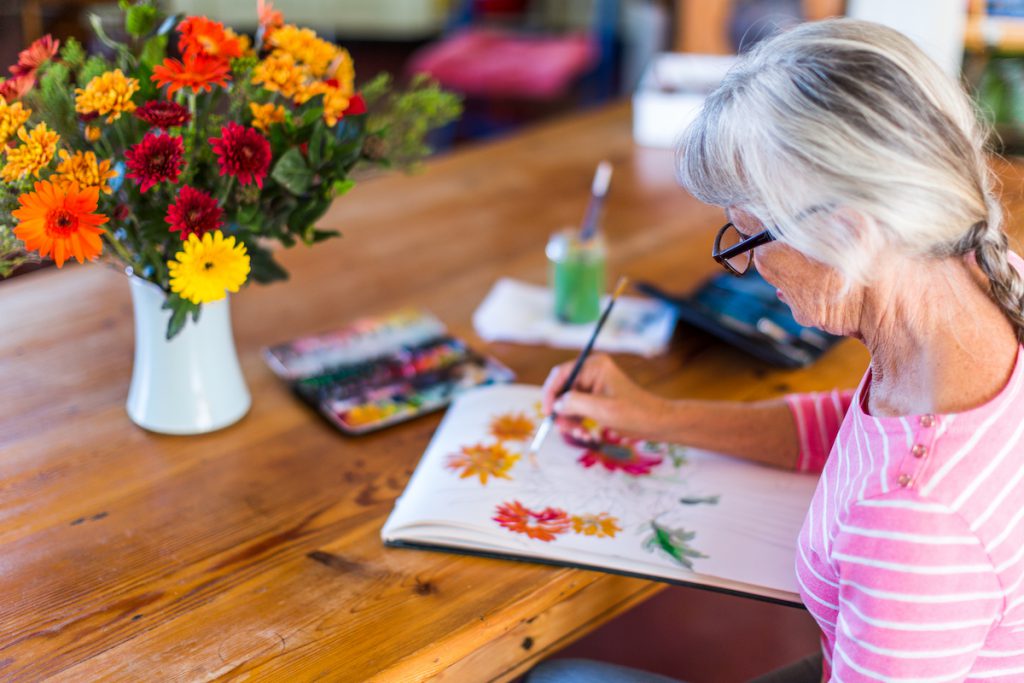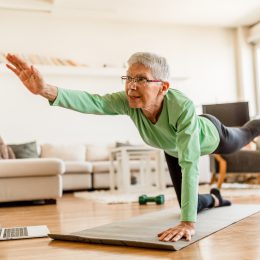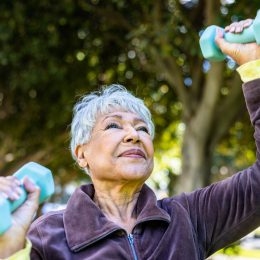The Health Benefits of Creativity
Now is the perfect time to take up painting, pottery, or any other artistic endeavor. Here’s why.

Even if you don’t consider yourself a creative person, it might be time you took up painting, knitting, or piano. And not just to pass the time.
It turns out fostering your creativity can promote better physical and mental health, according to a comprehensive report by the World Health Organization that looked at more than 3,000 studies on the topic.
The report found that engaging in the arts benefits health in two primary ways:
- It promotes good overall well-being, helping prevent the onset of a range of mental and physical conditions. Those include cognitive decline and frailty — a catchall term for various age-related health problems, such as an increased risk of falls, fractures, and muscle weakness.
- It helps in the management and treatment of chronic health conditions, such as depression, post-traumatic stress disorder (PTSD), dementia, and more. This is true for people living with chronic conditions as well as for their caregivers who engage in creative activities.
Emotional well-being and fitness go together! With SilverSneakers, you can choose from dozens of different Community classes, visit a participating fitness location, or join one of 20+ SilverSneakers LIVE online classes. Check your eligibility here.
Practicing creativity is about more than just having fun — it also helps us think differently. A Creativity Research Journal study suggests that creative people are better at problem-solving, which helps them face life’s obstacles with less stress.
Another specific way that being creative benefits your health is that it can help you connect with others who have similar interests, countering the effects of social isolation, says Claire de Boer, director of the Doctors Kienle Center for Humanistic Medicine and Center Stage Arts in Health at Penn State Health Milton Hershey Medical Center.
“We want to prevent loneliness as we get older — it’s a mental health issue because it’s associated with cognitive decline,” de Boer says. “We want to increase social connection, cognitive skills, memory, and physical coordination. What’s beautiful about the arts is that we can do all that in ways that promote joy and connection.”
Ready to feed your creative side? The first step is simple: Be open to trying new things, de Boer says. Beyond that, consider these tips to reap the many benefits of being creative.
1. Forget What You Think It Means to “Be Creative”
There’s not just one way to be creative. In fact, creativity is all about using your imagination and trying new things to see what comes of it. As long as you’re doing that, you’re flexing your creative muscles.
Painting, photography, knitting, writing, and even cooking are all great creative outlets. For those who prefer more specific guidance, consider these two expert-backed suggestions:
Make music. Whether it’s learning to play guitar or dusting off your old piano books, making (and listening to) music engages every area of your brain, says Jenzi Silverman, Ph.D., a music and wellness instructor at the University of Minnesota Earl E. Bakken Center for Spirituality and Healing.
Her suggestion: Revisit instruments you played previously, perhaps as a child. “If you think you’ve lost all your skill on the piano, flute, saxophone, or whatever it might be, you haven’t. There’s going to be some muscle memory there.”
If you’re totally new to playing an instrument, start with something simple, such as the recorder or ukulele, Silverman suggests.
Take up dancing. It doesn’t get much more creative than expressing yourself through dance moves. Plus, dancing can help build balance and coordination, making you more confident on your feet, de Boer says.
You can put on some music and dance at home or try a dance fitness class. Line Dancing and Zumba Gold are two fun SilverSneakers LIVE classes. Or you can check your local community or cultural centers for free or low-cost options.
2. Focus on the Process
“Being creative is meant to be joyful, with less emphasis on the finished product than the making itself,” de Boer says. “What we’re looking for in art-making is a state that’s similar to mindfulness practices like meditation — where it brings you tremendous focus.”
For some people, this might mean embracing being a beginner. Learning any new skill takes time, de Boer says, so it’s best so start small, take it one step at a time, and try to get lost in the present moment.
3. Sign Up for Lessons
Community centers, senior centers, and public libraries often offer lessons on all kinds of creative endeavors, from arts and crafts and creative writing to music and storytelling.
Businesses in your community may also offer classes where you can learn from the experts. Interested in plays and musicals? Attend an acting workshop at a local theater. Always wanted to make pottery but don’t have room in your home for a pottery wheel? Take a class at a nearby ceramics studio.
You can also check out free online classes through YouTube. Simply type whatever topic you want to learn about into the search bar (“beginner watercolor painting lessons” or “salsa dancing for beginners,” for example). Once you’ve found a video you like, subscribe to the creator’s channel (it’s free) to keep up with their latest offerings.
4. Find a Supportive Community
Whatever creative activity you want to pursue, there’s probably a local or virtual group you can join. “Making music together, or just being part of a like-minded community is a tremendous boost for mental health,” Silverman says.
Subscribe to our newsletter
It's quick and easy. You could be one of the 13 million people who are eligible.
Already a member? Click to discover our 15,000+ participating locations.
Follow Us
Even if you don’t meet in person, being part of a Facebook group is a great way to feel a sense of camaraderie in your newfound creative outlet. You can share photos of your completed projects, ask for advice, troubleshoot, and get help finding additional resources.
For example, the Facebook group Acrylic Pour by Seniors connects older adults interested in acrylic painting and encourages its members to share photos of their art (good and bad), while Knitting and Crafting for Beginners and Beyond brings together people of all knitting levels to enjoy each other’s company.
5. Ask Your Health Care Provider for Suggestions
Health centers often have general arts programs, such as community painting classes or craft events, as well as programs designed for specific health conditions. If your provider doesn’t offer these programs, there’s a good chance they can recommend options that meet your needs.
One such example is Dance for PD, a nonprofit that offers dance classes designed for people with Parkinson’s disease. They’re available online (danceforparkinsons.org), in New York City, and through a network of partners in more than 300 communities in 25 countries.
6. Make Creativity a Habit
Like any healthy habit, such as eating well or exercising, consistency is key to reaping the most benefits from your creative endeavors. Exactly what that looks like will depend on your schedule.
De Boer advocates doing a little something creative every day, even if it’s just for 10 minutes. If that’s not possible, think of it like this: “Physical exercise is really good for your body, and the arts are really good for your mental health. So, if you aim to exercise three or four times per week, try to do the same for your creative activities,” she says.
Another way creative pursuits are similar to your workouts: If it stops being fun and feels more like a chore, it’s time to reconsider and move on to something else. Above all, being creative shouldn’t add to your stress, de Boer says. “The arts are all about reducing stress.”
Take Your Favorite SilverSneakers Classes Online!
SilverSneakers members can access live fitness classes and wellness workshops through SilverSneakers LIVE. See the latest schedule and RSVP for classes here.
Not a member? If you have a Medicare Plan, it may include SilverSneakers—at no additional cost. Check your eligibility instantly here.
Not eligible for SilverSneakers? You can still get 200+ free SilverSneakers On-Demand videos and stay in touch with us by creating your online account.




